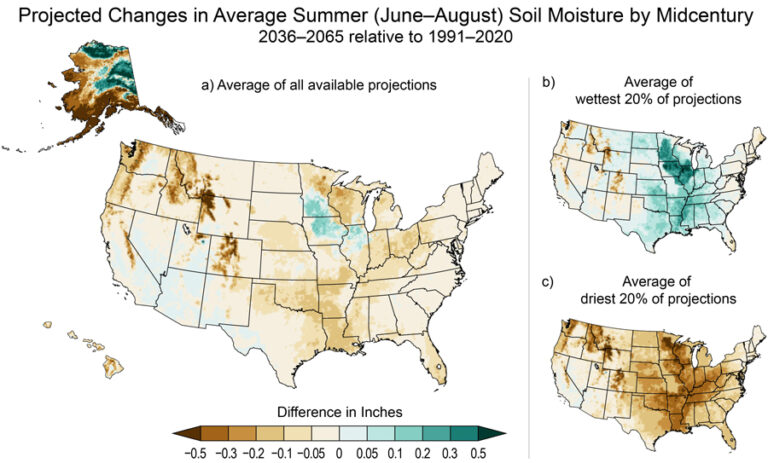Map: Under an intermediate scenario, soil moisture is projected to decrease during the summer months for most of the country (a), with the West seeing decreases even under the wettest projections. Exceptions include portions of the Upper Midwest and Alaska. The range between the wettest (b) and driest (c) projections illustrate the uncertainty in summer soil projections. Figure credit: University of Colorado Boulder, NOAA’s National Centers for Environmental Information (NOAA/NCEI), and the Cooperative Institute for Satellite Earth System Studies in North Carolina (CISESS NC).
The Fifth National Climate Assessment (NCA5) represents the latest science in assessing changes in the climate, its national and regional impacts, and options to reduce present and future risk. Every five years, the U.S. Global Change Research Program releases a new National Climate Assessment. The newest assessment, NCA5, is a resource to understand how drought will change as the climate changes, how we can adapt, and how future droughts might impact your region and livelihood.
Check out these 10 maps and graphics to learn more about drought in a changing climate.
Summer soil moisture will likely decrease
One of the ways we can understand drought is through the water stored in soil, soil moisture. Soil moisture supports agricultural crops and ecosystems and is a factor in how much precipitation and snowmelt becomes runoff in streams and rivers. Across most of the U.S., summer soil moisture is expected to decrease, with the greatest decreases in southern Alaska and the mountain ranges of the Western U.S.
Learn more about projected changes in drought in the water chapter.
Evapotranspiration will change
For the most part, precipitation has increased in the Eastern U.S. and decreased in the Western U.S. over the 20th–21st centuries. But across nearly the entire nation, average annual temperatures are rising. That warming alters the amount of evapotranspiration, a measure of the water used by plants and evaporating from the earth’s surface into the atmosphere. Actual evapotranspiration represents evaporative demand limited by the amount of water available to evaporate or transpire from plants into the atmosphere. This measure of evapotranspiration has trended lower in the Southwest as water availability has decreased, while it increased in the East and North. These trends are expected to continue under climate change.
Drought will look different across the nation
Climate change will cause drought to look different across the U.S. In the Western United States, more snow is expected to fall as rain, and mountain snowpacks are expected to melt earlier in the season, driving snow drought. In areas where snow is the dominant source of runoff, this will stress water supplies. In the Midwest, precipitation is expected to become more variable in winter and spring, making the region more susceptible to flash droughts, the rapid onset or intensification of drought. Along coasts and on islands, drought can drive saltwater intrusion into the water table, reducing the amount of fresh groundwater available. NCA5 includes chapters on the regional impacts of climate change, including changes in drought. Find the chapter for your region.
In a changing climate, drought will have a greater impact on human health
Depending on where you live, your allergies might be getting worse. The amount of pollen in the air has increased and is projected to continue to increase in many parts of the U.S. More plant and soil particulates that reduce air quality are expected to enter the atmosphere in warmer and drier conditions. But drought’s impact on human health can be far more serious than a runny nose. Drought is responsible for approximately 99 deaths per year over the last 40 years, measured by deaths associated with U.S. Billion-Dollar Weather and Climate Disasters as of 2022. In 2023, that number increased to 102 deaths per year. That number is likely underreported, as it only accounts for heat-related deaths accompanying droughts.
There are a number of other ways drought can drive mortality. Drought can lead to decreased […]
Full article: www.drought.gov

